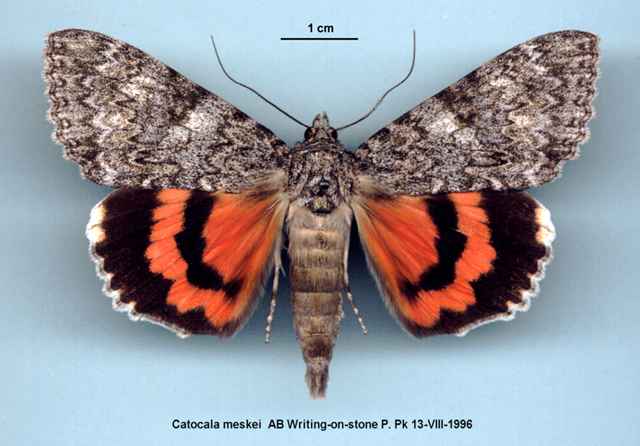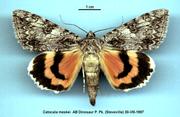« Back to your search
Species Details
Catocala meskei
University of Alberta E.H. Strickland Entomological Museum Read more about this collection »
Common NameMeske's Underwing
SeasonalityAdults are on the wing in Alberta from the last week in July through early September.
IdentificationA large (6.5-7.5 cm ws) moth with powdery grey forewings and deep red-orange hindwings. The forewings are grey and rather evenly patterned, with few contrasts or strong markings compared to similar species. The hindwings are deep red-orange or scarlet, with a wide outer black band. The narrower median black band extends almost to the anal margin, and usually has a short upward turn at the end that is separated from the rest of the band, or a small separate dark spot. The amount of contrast on the forewings may vary considerably, and occasional melanic specimens with much darker forewings occur. Meskei can be told from hermia and semirelicta by the red-orange rather than pink hindwings. Unijuga is larger and has wider dark bands on the hindwings, and more dark hairs in the basal area. The forewings are also more contrasting black and white, with stronger markings. Luciana and parta have paler orange-pink or salmon hindwings, not as dark or red as meskei. Some specimens of meskei ("form orion?") have much lighter, orange hindwings. Subspecies orion was described as a new species from Lethbridge. Another subspecies, concolorata, has also been reported from southern AB, but both names should probably be treated as forms rather than as subspecies.
Scientific Name
Catocala meskei
Common Name
Meske's Underwing
Habitat
Cottonwood forest along the river valleys of the plains.
Seasonality
Adults are on the wing in Alberta from the last week in July through early September.
Identification
A large (6.5-7.5 cm ws) moth with powdery grey forewings and deep red-orange hindwings. The forewings are grey and rather evenly patterned, with few contrasts or strong markings compared to similar species. The…
A large (6.5-7.5 cm ws) moth with powdery grey forewings and deep red-orange hindwings. The forewings are grey and rather evenly patterned, with few contrasts or strong markings compared to similar species. The hindwings are deep red-orange or scarlet, with a wide outer black band. The narrower median black band extends almost to the anal margin, and usually has a short upward turn at the end that is separated from the rest of the band, or a small separate dark spot. The amount of contrast on the forewings may vary considerably, and occasional melanic specimens with much darker forewings occur. Meskei can be told from hermia and semirelicta by the red-orange rather than pink hindwings. Unijuga is larger and has wider dark bands on the hindwings, and more dark hairs in the basal area. The forewings are also more contrasting black and white, with stronger markings. Luciana and parta have paler orange-pink or salmon hindwings, not as dark or red as meskei. Some specimens of meskei ("form orion?") have much lighter, orange hindwings. Subspecies orion was described as a new species from Lethbridge. Another subspecies, concolorata, has also been reported from southern AB, but both names should probably be treated as forms rather than as subspecies.
Life History
Adults are nocturnal and come to light, but are much more common at sugar baits. The adults eclose and lay eggs in the fall, which overwinter. There is a single brood each year.
Conservation
No concerns.
Diet Info
In Alberta, reared from Western Cottonwood (Populus sargentii). Elsewhere reported to use Poplars (Populus sp., including P. deltoides, P. grandidentata and P. nigra), and willows (Salix sp.)
In Alberta, reared from Western Cottonwood (Populus sargentii). Elsewhere reported to use Poplars (Populus sp., including P. deltoides, P. grandidentata and P. nigra), and willows (Salix sp.)
Range
Maine and Quebec west to southern Alberta and Montana, south to South Carolina in the east and at least Montana in the west. In Alberta it is present along the valleys of the grasslands region, north along the Red…
Maine and Quebec west to southern Alberta and Montana, south to South Carolina in the east and at least Montana in the west. In Alberta it is present along the valleys of the grasslands region, north along the Red Deer river to Tolman Bridge, east of Trochu. It is rather local, but may be fairly common when found.
References
Author
Prentice, R. M.
Title
Forest Lepidoptera of Canada. (1962)
Publication Date
1962
Volume
2
Pages
281
Author
Sargent, Theodore, D
Title
Legion of night : the underwing moths
Publication Date
1976
Pages
222
Specimen Information
There are 49 specimens of this Species.
UASM99242 - Catocala meskei
University of Alberta E.H. Strickland Entomological Museum
Place CollectedCanada: Alberta, Raymond
Date Collected1946-08-29
UASM99243 - Catocala meskei
University of Alberta E.H. Strickland Entomological Museum
Place CollectedCanada: Alberta, Raymond
Date Collected1966-09-04
UASM184986 - Catocala meskei
University of Alberta E.H. Strickland Entomological Museum
Place CollectedCanada: Alberta, Dinosaur Provincial Park
Collected ByTroubridge; Anweiler
Date Collected2001-08-14/2001-08-15
UASM184987 - Catocala meskei
University of Alberta E.H. Strickland Entomological Museum
Place CollectedCanada: Alberta, Dinosaur Provincial Park
Collected ByTroubridge; Anweiler
Date Collected2001-08-14/2001-08-15
UASM184988 - Catocala meskei
University of Alberta E.H. Strickland Entomological Museum
Place CollectedCanada: Alberta, Dinosaur Provincial Park
Collected ByTroubridge; Anweiler
Date Collected2001-08-14/2001-08-15
UASM184989 - Catocala meskei
University of Alberta E.H. Strickland Entomological Museum
Place CollectedCanada: Alberta, Writing-On-Stone Provincial Park
Collected ByAnweiler, G.
Date Collected2002-09-03
UASM184990 - Catocala meskei
University of Alberta E.H. Strickland Entomological Museum
Place CollectedCanada: Alberta, Writing-On-Stone Provincial Park
Collected ByAnweiler, G.
Date Collected2002-09-03



